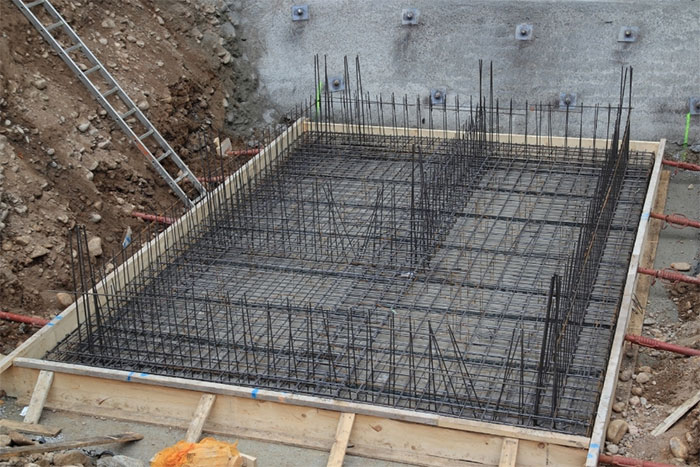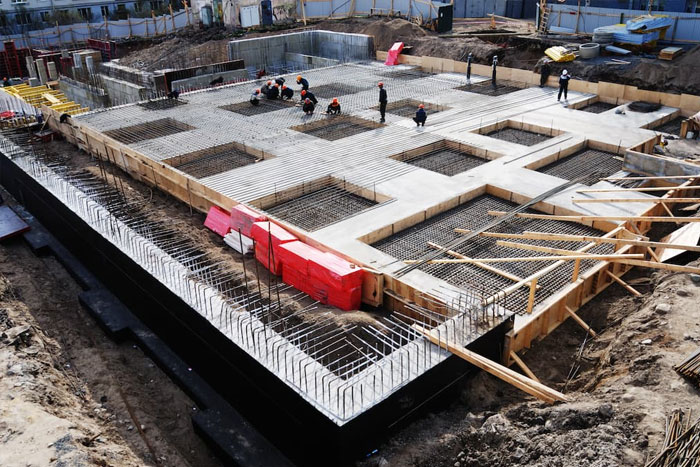
Foundation in construction are the cornerstone of any construction endeavor, providing essential stability and support to buildings and structures. Whether shallow or deep, meticulously designed foundations are crucial for safely transferring loads to the underlying soil or bedrock, minimizing settlement, instability, and structural risks.
What is a foundation in construction?
foundation in buildings is the structural component upon which a building or structure rests. It is designed to transfer the load of the building safely to the ground while providing stability and support.
There are several types of foundations used in construction, including:
- Shallow foundations: These are typically used for smaller structures and involve spreading the load over a larger area close to the surface. Examples include strip footings, pad footings, and raft foundations.
- Deep foundations: These are used when the soil near the surface is not able to support the weight of the structure or when there are other considerations such as unstable soil conditions. Examples include pile foundations and drilled shafts.
What is the purpose of foundations in construction?
Foundations are typically built below ground level and serve several purposes:
- Support: Foundations distribute the weight of the building evenly over the soil or substrate beneath it, preventing excessive settlement or movement.
- Stability: Foundations anchor the structure to the ground, preventing it from shifting or toppling over due to forces such as wind, earthquakes, or soil erosion.
- Leveling: Foundations provide a level and solid base for the construction of the building above, ensuring that floors, walls, and other structural elements are properly aligned.
Read more: Playground construction using geomembranes
The main types of foundations used in construction
The main types of foundations used in construction can be broadly categorized into shallow foundations and deep foundations. Here’s a brief overview of each:
- Shallow Foundations:
- Strip Footing: A continuous strip of concrete that supports a load-bearing wall or a line of closely spaced columns. It spreads the building load over a larger area.
- Pad Footing: Also known as spread footing, this type of foundation consists of a single concrete pad that supports an individual column or point load.
- Raft Foundation: Also called mat foundation, it is a large concrete slab that supports the entire structure. It spreads the load over the entire area of the building footprint.
- Deep Foundations:
- Pile Foundation: Consists of long, slender columns (piles) driven or drilled into the ground to transfer the load to deeper, more stable soil or rock layers.
- Drilled Shaft Foundation: Also known as drilled piers or caissons, these are large-diameter, deep concrete foundations formed by drilling a hole into the ground and filling it with concrete.
- Screw Piles: These are helical piles that are screwed into the ground using specialized equipment. They are often used in situations where traditional foundations are difficult to install.
What are the requirements for a good foundation?
A good foundation in construction must meet several key requirements to ensure the stability, durability, and safety of the structure it supports. Here are some essential requirements for a good foundation:
- Adequate Bearing Capacity: The foundation must be able to support the weight of the structure without excessive settlement or movement. This requires an understanding of the soil conditions at the site and ensuring that the foundation is designed to distribute the load effectively.
- Stability: The foundation must be stable and resistant to overturning, sliding, or uplift forces. This may involve proper anchoring techniques, ensuring adequate embedment depth, and accounting for lateral loads such as wind or seismic forces.
- Compatibility with Soil: The foundation should be compatible with the soil conditions at the site. This includes considerations such as soil type, moisture content, and potential for settlement or expansion. Proper soil testing and analysis are essential for determining the most suitable foundation type and design.
- Protection from Moisture: The foundation must be designed to protect against moisture infiltration, which can lead to deterioration of the structure over time. This may involve measures such as proper drainage, waterproofing, and adequate sealing of joints and penetrations.
- Durability: The foundation should be built using durable materials and construction techniques to ensure long-term performance and minimize maintenance requirements. This may include using high-quality concrete, corrosion-resistant reinforcement, and proper curing methods.
- Compliance with Building Codes and Regulations: The foundation must meet the requirements of local building codes and regulations, which specify minimum standards for structural design, materials, construction methods, and safety considerations.
- Accessibility for Inspection and Maintenance: The foundation should be constructed in a way that allows for easy access for inspection, maintenance, and repairs as needed. This may involve leaving access points for utilities, providing clearances around foundation walls, and ensuring adequate ventilation.
- Compatibility with Superstructure: The foundation design must be compatible with the intended superstructure, including considerations such as building layout, column spacing, wall placement, and floor elevations.
Read more: Geosynthetics In Pipeline Construction
What are the requirements for a good foundation?
A good foundation in construction must meet several key requirements to ensure the stability, durability, and safety of the structure it supports. Here are some essential requirements for a good foundation:
- Adequate Bearing Capacity: The foundation must be able to support the weight of the structure without excessive settlement or movement. This requires an understanding of the soil conditions at the site and ensuring that the foundation is designed to distribute the load effectively.
- Stability: The foundation must be stable and resistant to overturning, sliding, or uplift forces. This may involve proper anchoring techniques, ensuring adequate embedment depth, and accounting for lateral loads such as wind or seismic forces.
- Compatibility with Soil: The foundation should be compatible with the soil conditions at the site. This includes considerations such as soil type, moisture content, and potential for settlement or expansion. Proper soil testing and analysis are essential for determining the most suitable foundation type and design.
- Protection from Moisture: The foundation must be designed to protect against moisture infiltration, which can lead to deterioration of the structure over time. This may involve measures such as proper drainage, waterproofing, and adequate sealing of joints and penetrations.
- Durability: The foundation should be built using durable materials and construction techniques to ensure long-term performance and minimize maintenance requirements. This may include using high-quality concrete, corrosion-resistant reinforcement, and proper curing methods.
- Compliance with Building Codes and Regulations: The foundation must meet the requirements of local building codes and regulations, which specify minimum standards for structural design, materials, construction methods, and safety considerations.
- Accessibility for Inspection and Maintenance: The foundation should be constructed in a way that allows for easy access for inspection, maintenance, and repairs as needed. This may involve leaving access points for utilities, providing clearances around foundation walls, and ensuring adequate ventilation.
- Compatibility with Superstructure: The foundation design must be compatible with the intended superstructure, including considerations such as building layout, column spacing, wall placement, and floor elevations.
Why are geosynthetics used in the foundation in building construction?
Geosynthetic products include geocomposite sheets, geotextile, geogrid, geocells are materials manufactured from synthetic polymers and are commonly used in foundation construction for several reasons:
- Soil Reinforcement: Geosynthetics such as geogrids and geotextiles are often used to reinforce soil, enhancing its strength and stability. They can be placed within the soil to improve its load-bearing capacity, reduce settlement, and prevent soil erosion.
- Drainage Improvement: Geosynthetics like geocomposites and geonets are used to provide effective drainage solutions in foundation systems. They help in the rapid removal of excess water from the soil, reducing hydrostatic pressure and preventing waterlogging, which can lead to soil instability and foundation failure.
- Soil Separation: Geotextiles are commonly used to separate different soil layers with varying properties, preventing mixing and maintaining the integrity of each layer. This helps to prevent the loss of structural support and reduces the potential for settlement.
- Erosion Control: Geosynthetics are used to control erosion on slopes, embankments, and other vulnerable areas within foundation systems. They help to stabilize the soil surface, prevent surface erosion due to rainfall or runoff, and protect the integrity of the foundation.
- Barrier Functions: Certain geosynthetics, such as geomembrane sheets, serve as impermeable barriers to prevent the migration of fluids or gases. They are used in applications such as lining ponds, reservoirs, and landfills to contain contaminants and protect the surrounding environment.
- Construction Efficiency: Geosynthetics offer advantages in terms of ease of handling, installation, and transportation compared to traditional construction materials. They are lightweight, flexible, and can be manufactured in large rolls, making them cost-effective and efficient to use in foundation construction.
- Environmental Benefits: Geosynthetics are often considered more environmentally friendly compared to traditional construction materials. They can be made from recycled materials, and their use can minimize the need for excavation, reduce construction waste, and mitigate environmental impacts associated with soil disturbance.
Conclusion
In conclusion, foundations are critical components of construction projects, providing essential support, stability, and durability to buildings and structures. Whether shallow or deep, properly designed and constructed foundations ensure the safe transfer of loads to the underlying soil or bedrock, mitigating settlement, instability, and structural failure. By meeting key requirements such as adequate bearing capacity, stability, compatibility with soil conditions, and compliance with regulations, foundations play a foundational role in the integrity and longevity of the built environment.





